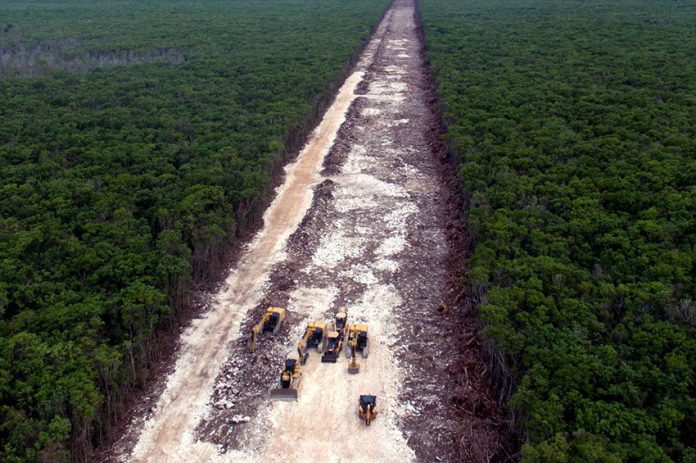The federal Environment Ministry (Semarnat) has approved the environmental impact statement (EIS) for the southern section of the Quintana Roo stretch of the Maya Train railroad, determining that the project is “environmentally feasible.”
Conditional approval of the more than 6,000-page EIS for the controversial Playa del Carmen-Tulum section (Tramo 5 Sur) was granted in just 36 days after being submitted to Semarnat by the National Tourism Promotion Fund (Fonatur) in mid-May.
A federal judge last month issued a definitive suspension order against construction of the 67.6-kilometer section — part of the longer Cancún-Tulum stretch — due to the absence of an authorized EIS, but that ruling now looks set to be overturned. Fonatur, which is managing the US $10 billion, 1,500-kilometer Maya Train project, has already applied for the revocation of the definitive suspension order, but the resumption of work on Tramo 5 Sur — stalled since mid-May — could still be delayed by four provisional suspension orders.
There is considerable opposition to the Playa del Carmen-Tulum section because it will run through jungle and over subterranean rivers and cenotes (natural sinkholes). The definitive suspension decision followed the granting of a provisional suspension order due to the “imminent risk” of “irreversible damage” to the Mayan jungle, caves, subterranean rivers and cenotes, and the absence of environmental studies and permits.

While Semarnat’s approval of the EIS is conditional, the conditions or restrictions imposed on the construction of Tramo 5 Sur — to be built by a subsidiary of the Grupo México conglomerate — have not been made public.
The EIS acknowledged that 485 hectares of jungle and land covered by secondary vegetation will be affected and described the impact as “critical.” It also envisaged “severe adverse” impacts to the habitat, the scenic quality of the landscape and natural sites and monuments. However, the negative impacts identified are “remediable,” the EIS said.
In a document submitted to Semarnat earlier this month, Greenpeace and the Center for Biological Diversity asserted that the EIS was invalid because it was published after work on Tramo 5 Sur began. The environmental organizations also said that the EIS had “a great number of omissions [and] imprecisions” and even “false information” about the limestone soils in Quintana Roo.
Its rapid approval is no surprise given that the Maya Train is one of the pet projects of President López Obrador, who asserts that the railroad will spur social and economic development in what he describes as Mexico’s long-neglected southeast.
Environment Minister María Luisa Albores acknowledged early last month that four sections of the train — including section 5 — didn’t have definitive environmental approval, but explained that their construction had been able to proceed thanks to a presidential decree issued in November.
López Obrador in late May claimed that the Mérida-based judge who issued the definitive suspension order against Tramo 5 Sur had failed to take into account that the decree, which established the government’s infrastructure projects as matters of public interest and national security, allowed them to proceed with only provisional approval.
The president has pledged that the railroad — on which tourist, commuter and freight trains will run through Tabasco, Campeche, Yucatán, Quintana Roo and Chiapas — will begin operations in 2023, but two people working on the ambitious project claimed earlier this month that the it won’t be finished while the current federal government is in office, if at all.
With reports from Reforma, El Economista and Proceso
